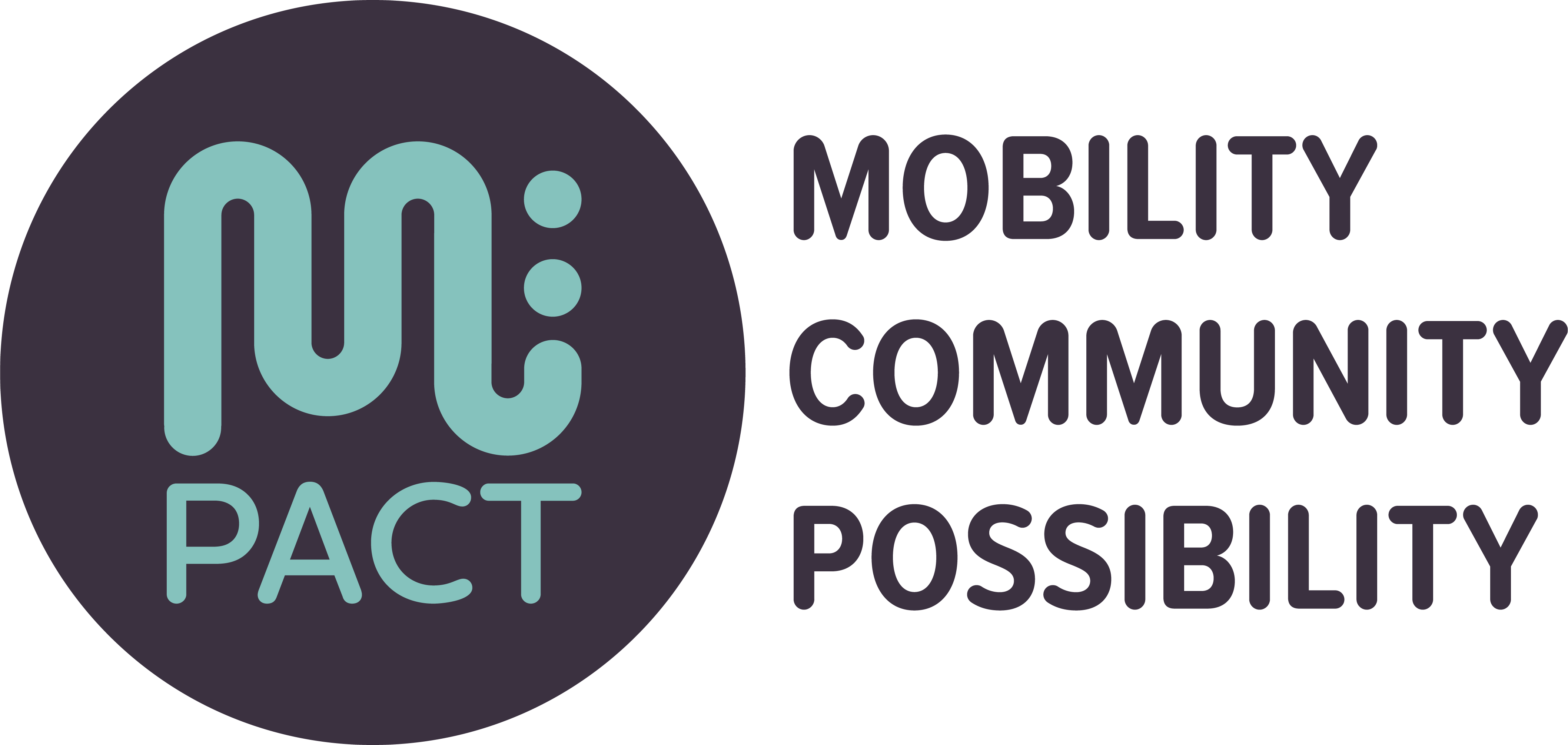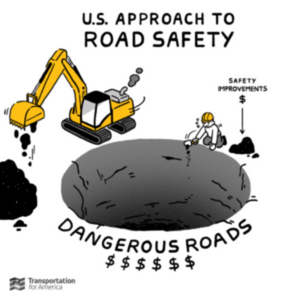Originally published on railvolution.org. Rail~Volution is now Mpact: Mobility, Community, Possibility.
Is it finally infrastructure week? Or year or decade? We’ve been tracking many recent stories about the new US infrastructure bill and have compiled some key perspectives for you below. We share many of these viewpoints — from concern about the vast increase in funding going to roads without adequate provision to prioritize repair, to relief over the increased funding for transit, which will provide welcome stability for transit agencies as they work to build service levels and meet riders’ needs. The bill also includes big investments in high-speed rail and electric charging stations.
Three big take-aways:
- A lot will depend on how the money is spent, meaning that there is a big opportunity to push for better outcomes via local, state and federal policy and rule making.
- The Build Back Better reconciliation bill (supposedly heading to a vote in November) includes important provisions for improving access to transit, grants for reducing emissions and funds for affordable housing.
- We need continued pressure at all levels of government to prioritize outcomes that expand affordable access to transportation and housing, help tackle climate change and build healthier communities.
Read on for a compilation of stories about the infrastructure bill and expectations for the reconciliation bill.
THE INFRASTRUCTURE BILL – summaries and comments
White House Fact Sheet: The Bipartisan Infrastructure Deal
Link
From the bill summary:
- “The legislation will reauthorize surface transportation programs for five years and invest $110 billion in additional funding to repair our roads and bridges and support major, transformational projects. . . . The legislation also includes the first ever Safe Streets and Roads for All program to support projects to reduce traffic fatalities, which claimed more than 20,000 lives in the first half of 2021.”
- “The legislation includes $39 billion of new investment to modernize transit, in addition to continuing the existing transit programs for five years as part of surface transportation reauthorization. In total, the new investments and reauthorization in the Bipartisan Infrastructure Deal provide $89.9 billion in guaranteed funding for public transit over the next five years.”
- “The legislation positions rail to play a central role in our transportation and economic future, investing $66 billion in additional rail funding to eliminate the Amtrak maintenance backlog, modernize the Northeast Corridor, and bring world-class rail service to areas outside the northeast and mid-Atlantic.”
- “The legislation will invest $7.5 billion to build out a national network of EV chargers in the United States.”
- “The Bipartisan Infrastructure Deal’s more than $65 billion investment includes the largest investment in clean energy transmission and grid in American history. It will upgrade our power infrastructure, by building thousands of miles of new, resilient transmission lines to facilitate the expansion of renewables and clean energy, while lowering costs. And it will fund new programs to support the development, demonstration, and deployment of cutting-edge clean energy technologies to accelerate our transition to a zero-emission economy.”
- “An investment of over $50 billion to protect against droughts, heat, floods and wildfires, in addition to a major investment in weatherization. The legislation is the largest investment in the resilience of physical and natural systems in American history.”
American Public Transportation Association (APTA)
Link
APTA’s President and CEO Paul P. Skoutelas said, “The $107 billion for public transit and $102 billion for commuter rail, Amtrak, and other high-performance rail in this bill will build infrastructure that will make public transportation faster, more modern, and more reliable, while tackling climate change, advancing equity issues, and providing growing communities sustainable mobility options. . . . Even with this critical legislative victory, there is still work to be done. APTA will continue working with Congress and the Administration to advance the Build Back Better Act and ensure that we make the necessary investments to ensure public transit access to affordable housing and build high-speed passenger rail.”
Transportation for America – Step one for repairing a problem: Stop making it worse
Link
 The illustration was produced for T4America by visual artist Jean Wei. IG/@weisanboo
The illustration was produced for T4America by visual artist Jean Wei. IG/@weisanboo
“Swap in any pressing issue—climate change, repair, safety—and this new illustration describes the approach to solving it within the much-debated infrastructure bill.”
T4A Executive Director Beth Osborne: “[The deal] spends a lot of money but fails to target it to the needs of the day: building strong economic centers, providing equitable access to opportunity, addressing catastrophic climate change, improving safety, or repairing infrastructure in poor condition.”
TheT4A post points out that infrastructure bill could have been much better if it had followed the framework of the House’s five year INVEST Act proposal.
Streetsblog: The Infrastructure Bill: What’s In It For Us? – Garesh Kuntzman
Link
This Streetsblog article points out the “scores of billions of dollars for new and expanded car infrastructure, including almost $110 billion for new roads and repaired bridges” and notes that the bill “also shelved the ‘fix-it first’ promises that President Biden made when he ran for the White House.
Streetsblog also referenced key points from other sources:
- Carlton Reid of Forbes noticed something disquieting buried in the bill. “An easy-to-miss part of the Act also formalizes the acceptance of so-called ‘vehicle to everything’ (V2X) technology. . . . Reid cautions that the long-term goal is to require bikes and pedestrians to be wearing beacons — which will lead to pedestrians and cyclists being blamed for their own deaths
- David Zipper of the Harvard Kennedy School and a longtime transportation expert, noticed some small print requiring the feds to “establish a pilot program to demonstrate a national motor-vehicle per-mile user fee.”
Streetsblog – How the New Infrastructure Deal Will Make Transit Better – Kea Wilson
Link
This Streetsblog piece goes into more detail about a couple of the areas funded in the bill:
- “$1.75 billion specifically to retrofit stations and provide the new infrastructure that people with mobility challenges need most. . . . The Federal Transit Administration estimates that almost one-fifth of transit stations aren’t accessible today.”
- “$1 billion Reconnecting Communities pilot, which will provide federal assistance to cities considering removing, bridging or otherwise addressing the damages of interstates that tore apart primarily BIPOC communities during the urban renewal era and beyond. . . . transit projects areeligible for part of the funds — as they are for a few other pots of transit money like the $7.5 billion RAISE grant program, over which Secretary Pete Buttigieg and his colleagues will have sole discretionary authority.”
MZ Strategies – We’ve got the money. Now what? In search of Transportation Equity
Link
Mariia Zimmerman’s take on the bill includes key points and additional links:
- The bulk of funding —- and even projects funded through these new programs — will require significant change in how state departments of transportation, transit agencies, metropolitan planning organizations and localities prioritize funding requests, design projects, and involve community especially those who are most impacted and that have been historically underrepresented. As noted in the New York Times piece by Zolan Kanno-Youngs and Madeleine Ngo, “Racial Equity in Infrastructure, a US Goal, is left to States.” This is putting a lot of money (and faith) in a set of players who have not historically risen to the challenge of racial equity or environmental stewardship.
- [The infrastructure bill] fails to provide federal operating assistance enabling better pay for drivers and to make transit fares more affordable for low-income riders. This comes despite the pandemic showing how essential transit is to low-income workers. Service cuts on many bus and rail routes were devastating for these riders. Bus operators served on the front line, and too many died early in the pandemic. Today many systems are struggling to maintain and recruit new drivers as private sector employers like Amazon can offer better wages. Transit equity remains an elusive goal in almost every US city.
- For transit-oriented development (TOD) fans, the increased formula funding for buses, light rail, ferries, heavy rail and transit service expansion is good news. But little other direct TOD funding is provided. Yes, it extends FTA’s TOD pilot planning program which grows from $13.1 million in FY22 to $14.4 million in FY2026. [For more about this program, see our January 2021 webinar, Effective, Contextual Planning Using the FTA TOD Pilot Program.]
BUILD BACK BETTER
Transportation for America
In the same post linked above, T4A noted that the Build Back Better reconciliation bill “does include some important provisions for improving access to transit, grants for reducing emissions, and more. But it’s tough to swallow knowing that the infrastructure deal is likely to make many of these same issues worse…”
National Low Income Housing Coalition – Statement on Housing Investments in “Build Back Better Act” – October 28
Link
“The $1.75 trillion economic recovery package – negotiated down from $3.5 trillion – includes $150 billion in affordable housing investments. Seventy percent of the investments are deeply targeted in the National Low Income Housing Coalition’s (NLIHC’s) HoUSed Campaign’s top priorities: rental assistance, public housing, and the national Housing Trust Fund.”
Streetsblog
The piece linked above, The Infrastructure Bill: What’s In It For Us?, captures the urgency of the reconciliation bill in this quote: “We eagerly await passage of the Build Back Better Act, with its $10 billion to improve access to transit in low-income communities, which would mark a historic advance toward transportation equity,” said Danny Pearlstein, the spokesman for Riders Alliance, a transit advocacy group in New York City.
Streetsblog continues:
“As we previously reported, some of the most consequential new sustainability programs aren’t included in the Infrastructure Investment and Jobs Act at all — because they’re buried in the Build Back Better Act, which is now supposed to pass later this month. Lydia DePillis, of ProPublica, did an epic weekend-long thread that revealed the transportation goodies (beyond billions for housing, health care and climate resiliency) in that bill:
- $100 million for the Forest Service to rebuild trails, “with a priority on trails that provide to underserved communities access to National Forest System land.”
- $2 billion to help corporations and port operators replace dirty vehicles with clean ones.
- $95 million in grant money to increase urban composting.
- $5 billion in loans to communities whose economies are closely associated with fossil fuel extraction and production.
- $4 billion to help heavy industry decarbonize.
- An end to oil exploration leases in the Arctic National Wildlife Refuge.
- Close to $6 billion to help the Postal Service and the General Services Administration buy zero-emission vehicles.”
WHAT’S NEXT?
As we noted at the start of this post, there is a big opportunity to push for better outcomes via local, state and federal policy and rule making. We need continued pressure at all levels of government to prioritize outcomes that expand affordable access to transportation and housing, help tackle climate change and build healthier communities.



